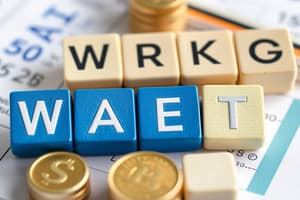Podcast
Questions and Answers
Which scenario exemplifies the need for start-up capital?
Which scenario exemplifies the need for start-up capital?
- A business paying off existing debts to improve cash flow.
- A business purchasing essential fixed assets and current assets. (correct)
- A business maintaining its current infrastructure.
- A business researching new product development.
Which action will most effectively improve a business's working capital position?
Which action will most effectively improve a business's working capital position?
- Expediting payments to creditors while offering extended payment terms to debtors.
- Expediting payments from debtors and delaying payments to creditors. (correct)
- Negotiating a debt consolidation loan with a higher interest rate.
- Delaying payments to debtors and accelerating payments to creditors.
A company purchases new machinery that is expected to last five years. This is an example of what type of expenditure?
A company purchases new machinery that is expected to last five years. This is an example of what type of expenditure?
- Capital expenditure (correct)
- Revenue expenditure
- Operational expenditure
- Working capital
How is revenue expenditure typically financed?
How is revenue expenditure typically financed?
How can selling shares as a source of finance impact a company?
How can selling shares as a source of finance impact a company?
Which of the following is an example of an internal source of finance?
Which of the following is an example of an internal source of finance?
A business sells a piece of land and then leases it back. What is a potential disadvantage of this approach?
A business sells a piece of land and then leases it back. What is a potential disadvantage of this approach?
What is a potential drawback of using overdrafts as a source of finance?
What is a potential drawback of using overdrafts as a source of finance?
In debt factoring, what percentage of an existing debt do agencies typically offer?
In debt factoring, what percentage of an existing debt do agencies typically offer?
What is a key disadvantage of using retained profits to finance business activities?
What is a key disadvantage of using retained profits to finance business activities?
Which of the following best describes 'cost-plus pricing'?
Which of the following best describes 'cost-plus pricing'?
Which type of cost remains the same regardless of production levels?
Which type of cost remains the same regardless of production levels?
If a firm adopts automation to reduce labor costs, what would be a potential impact on their break-even point?
If a firm adopts automation to reduce labor costs, what would be a potential impact on their break-even point?
What is the primary purpose of preparing budgets in the context of cost information?
What is the primary purpose of preparing budgets in the context of cost information?
Why is it important to distinguish between revenue and capital expenditure?
Why is it important to distinguish between revenue and capital expenditure?
What does a high gearing ratio indicate about a business?
What does a high gearing ratio indicate about a business?
Which action can improve a business's gross profit margin?
Which action can improve a business's gross profit margin?
What might a low acid test ratio indicate?
What might a low acid test ratio indicate?
How can a business improve its cash inflows?
How can a business improve its cash inflows?
Which is a potential disadvantage of relying heavily on cash flow forecasts?
Which is a potential disadvantage of relying heavily on cash flow forecasts?
Flashcards
Business Finance
Business Finance
The amount of money a business needs to buy assets and pay expenses.
Start-up Capital
Start-up Capital
Finance used for essential fixed assets (Land, Building, Car etc.) and current assets to start a business.
Capital for Expansion
Capital for Expansion
Finances needed to buy fixed assets or invest in new product development.
Working Capital
Working Capital
Signup and view all the flashcards
Revenue Expenditure
Revenue Expenditure
Signup and view all the flashcards
Capital Expenditure
Capital Expenditure
Signup and view all the flashcards
Internal Source of Finance
Internal Source of Finance
Signup and view all the flashcards
Retained Profit
Retained Profit
Signup and view all the flashcards
Sale of Assets
Sale of Assets
Signup and view all the flashcards
Sale and Leaseback
Sale and Leaseback
Signup and view all the flashcards
Managing Working Capital
Managing Working Capital
Signup and view all the flashcards
External Source of Finance
External Source of Finance
Signup and view all the flashcards
Overdrafts
Overdrafts
Signup and view all the flashcards
Debt-Factoring
Debt-Factoring
Signup and view all the flashcards
Hire Purchase
Hire Purchase
Signup and view all the flashcards
Debentures
Debentures
Signup and view all the flashcards
Share Capital
Share Capital
Signup and view all the flashcards
Mortgages
Mortgages
Signup and view all the flashcards
Micro-finance
Micro-finance
Signup and view all the flashcards
Crowd funding
Crowd funding
Signup and view all the flashcards
Study Notes
The Need for Business Finance
- Finance is used to acquire assets and cover expenses.
- Crucial for revenue generation and business sustainability.
- Start-up capital is the finance needed for essential fixed assets and current assets to initiate business operations.
- Additional working capital covers capital expenditure or revenue expenditure.
- Research and development finances new products or marketing strategies.
Working Capital
- Covers day-to-day expenses like fuel, bills, and raw materials.
- It is the "bloodline" of a business.
- Failure to manage working capital can lead to business shutdown.
- Improve working capital by accelerating debtor payments and delaying creditor payments.
- Current assets are short-term assets held for less than a year.
- Current liabilities need to be settled within a year.
Revenue Expenditure and Capital Expenditure
- Revenue expenditure covers day-to-day expenses, providing short-term benefits like wages, fuel and rent.
- Capital expenditure concerns non-current assets with long-term benefits, such as buildings and vehicles.
- Revenue expenditure maintains the life of assets.
Significance of Distinguishing Between Expenditures
- They have different impacts on business, and are financed differently, and recorded differently in financial accounts.
- Revenue expenditure is short-term, regular: maintains assets
- Capital expenditure is long-term, irregular: produces assets.
- Capital expenditure utilizes debt/loan financing
- Revenue expenditure relies on working capital, trade credit, and credit cards.
- Revenue expenditure is recorded on the Income Statement
- Capital expenditure is recorded as depreciation on the Income Statement and as asset valuation on the Statement of Financial Position.
- Two financial accounts include both the income statement and balance sheet.
Sources of Finance
- Sources of finance are divided into short-term and long-term.
- Short-term sources like overdrafts and trade credit provide working capital for daily operations, repaid within a year.
- Long-term sources, used for fixed assets and acquisitions, are repaid over a year.
Internal Sources of Finance
- Internal sources originate within the business.
- Retained profits are reinvested after-tax earnings, recommended due to no borrowing costs.
- Selling idle assets generates funds without incurring debt.
- Sale and leaseback involves selling assets and leasing them back.
- Working capital can be managed through payment strategies.
External Sources of Finance
- External sources come individuals/institutions like banks or government.
- Overdrafts provide the right to overdraw, but with high interest rates.
- Trade credit involves purchasing goods from suppliers with deferred payment.
- Debt factoring is buying a firm's debts for immediate cash, where agencies offer a percentage of the debt.
- Hire purchase involves a down payment with installments for asset acquisition.
- Leasing is renting assets via monthly.
- Money for bank loans is borrowed with interest.
- Debentures raise funds, so debenture holders serve as creditors.
- Share capital involves raising capital by selling shares. Venture capital is long-term investment from venture capitalists.
- Mortgages are loans secured for land/buildings. New partners bring additional funding.
- Micro-finance provides financial services to those traditional banks ignore.
- Crowd funding raises money from a large number of individuals.
- Government grants are sums of money given to businesses for a specific purpose.
Factors Influencing Choice of Finance
- Consider cost, flexibility, control retention, intended use, and existing debt levels when choosing sources of finance.
- High existing debt advises against bank loans, favoring options like issuing shares.
- Gearing Ratio indicates financial risk, calculated as non-current liabilities divided by capital employed.
Cost Accounting
- Needed by every firm for informed decisions.
Reasons to Have Accurate Cost Data
- To calculate profits/losses to maximize performance.
- To make comparisons to gauge company performance and strategies.
- To decide which resources to use (labor vs. automation).
- To prepare budgets for the future with targets and performance analysis.
- To determine pricing strategies, e.g., cost-plus or contribution pricing.
Revenues, Costs, and Profits
- Revenue is income from selling goods/services.
- Formula: Revenue = Quantity sold x Average selling price.
Costs
- Expenses a business pays to trade.
- Fixed costs: constant regardless of production level (rent, insurance).
- Variable costs: vary directly with production (wages, raw materials).
- Semi-variable costs: have fixed and variable components (telephone bill).
- Total Cost = Fixed cost + Variable Cost
- Average Cost is the per-unit cost of production, calculated by Total Costs / Total Output.
- Marginal costs is the cost to produce one extra units.
Direct and Indirect Costs
- Direct costs relate directly to the production of a product
- Indirect costs cannot be allocated
- Formula: Average Cost of Production
- Cost is an estimate figures
Profit
- Profit is the excess of revenue over costs, also calculated as Total Revenue - Total Cost.
Break-Even Analysis
- Break-even output: level where total costs equal total revenue.
- Break-even point: the business has made neither profit nor loss.
- Break-even charts graphically represent costs and revenues vs. sales.
Methods to Improve Break-Even
- Reduce fixed costs by cutting rent or insurance.
- Increase selling price by improving brand image or quality.
- Reduce variable costs by finding cheaper suppliers.
- Break Even can only provide provide the quantative data and Qualitative data in order to build strategy by the marketing department.
- Depends on how reliable is the data.
Studying That Suits You
Use AI to generate personalized quizzes and flashcards to suit your learning preferences.




